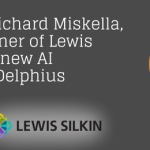 In our second ILTA briefing we caught up with Jeff Pfeifer (pictured), vice president of product management at LexisNexis, who discusses how big data is the challenge for lawyers today and how Lexis is rising to the challenge. Already in-house teams such as Apple and Microsoft are using analytics to drive change among their outside counsel and the adoption curve is notably widening within private practice in what Pfeifer describes as a “pivot” in the industry.
In our second ILTA briefing we caught up with Jeff Pfeifer (pictured), vice president of product management at LexisNexis, who discusses how big data is the challenge for lawyers today and how Lexis is rising to the challenge. Already in-house teams such as Apple and Microsoft are using analytics to drive change among their outside counsel and the adoption curve is notably widening within private practice in what Pfeifer describes as a “pivot” in the industry.
What is a key focus for LexisNexis at ILTA?
How attorneys are interacting with data differently out of necessity and how technology is creating an exciting pivot opportunity: the lawyer of the future has to be data driven. Many talk about being data driven but for us that means mining insights out of data that weren’t there previously.
For seven years we’ve been building a big data platform which is core to delivering on the vision for the data driven lawyer and underpins our analytics, machine learning and AI capability. The platform now contains 60bn documents and that is doubling every month.

Grid computing allows us to ingest and through cluster computing to establish entity relationships. In that area we have a sister company called Risk Solutions and we’ve been able to leverage that to establish 22 billion connections across those data sets.
We’re interested over time in building a platform as a service so customers can use this type of tagging on their own data.
Ravel is doing interesting work in written case law opinions using extensive machine learning technology and linguistic expression analysis to look at judicial preference while Lex Machina allows us to give the customer a lot more information into the likely outcome.
Intelligize explores many of the same issues in contract and transactional documents. They have built a similar machine learning-based language extraction on top of the US SEC rules – the really exciting thing is that we are now working to export that to law firm data so they can do the same kind of extraction and analysis on their own documents.
We’re best known for full-text search and semantic search but data visualisation, analytics, predictive analytics and machine learning and cognitive computing is what we are focussing on now.

What are the main trends you’re seeing among law firms and in-house teams?
We have really started to see a pivot change – early on we saw experts in firms likely to do analytics but it’s progressing along an adoption curve that’s wider now. There has been a big pick up this year in law firms and in-house departments driving a lot of activity in analytics. Law firms are modelling who is more productive, who achieve cases in the fastest time with the most desired outcome.
Analytics are being leveraged by in-house departments to a deep degree. Microsoft is shifting 90% of its work to an alternative fee basis and has a desire to better control its costs. Analytics can benchmark how teams are performing against their peer groups and can look across all outside law firms and see who provides the best return.
This is forcing law firms to look at their own litigation management. A few good examples of in-house teams applying analytics are Apple, which has really been a real driver and Microsoft; both were involved in the early days of Lex Machina because they wanted to better analyse litigation performance in their patent cases. Now we’re seeing interest not just from West Coast corporates but expansion into the likes of pharmaceutical companies and large retail companies which are exploring analytics.
What announcements do you have coming up?
We will shortly enable law firms to apply to their data contract analytics that allow you to do very granular earmarking of document types, extracting clause level analysis. We have solved the problem of how you deploy it behind the firewall: most firms are not willing to load their data into the commercial cloud but we’ve figured out how to apply the machine learning behind the firm’s firewall and we’ll be starting to roll that out in October.







